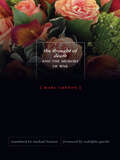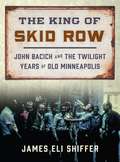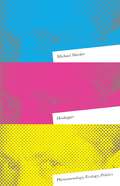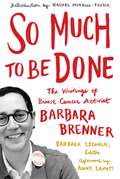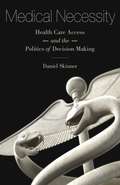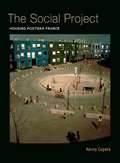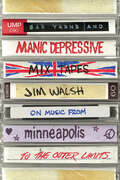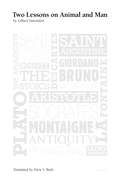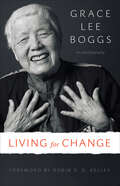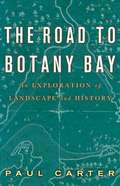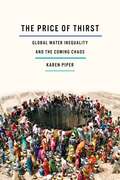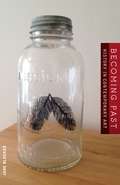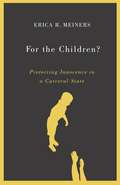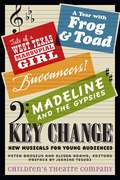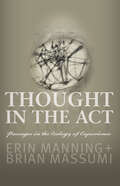- Table View
- List View
Neuropolitics: Thinking, Culture, Speed (Theory Out of Bounds #23)
by William E. ConnollyWhy would a political theorist venture into the nexus between neuroscience and film? According to William Connolly—whose new book is itself an eloquent answer—the combination exposes the ubiquitous role that technique plays in thinking, ethics, and politics. By taking up recent research in neuroscience to explore the way brain activity is influenced by cultural conditions and stimuli such as film technique, Connolly is able to fashion a new perspective on our attempts to negotiate-and thrive-within a deeply pluralized society whose culture and economy continue to quicken. In Neuropolitics Connolly draws upon recent brain/body research to explore the creative potential of thinking, the layered character of culture, the cultivation of ethical sensibilities, and the critical role of technique in all three. He then shows how a series of films-including Vertigo, Five Easy Pieces, and Citizen Kane-enhances our appreciation of technique and contests the linear image of time now prevalent in cultural theory. Connolly deftly brings these themes together to support an ethos of deep pluralism within the democratic state and a politics of citizen activism across states. His book is an original and rigorous study that attends to the creative possibilities of thinking in identity, culture, and ethics.
The Thought of Death and the Memory of War
by Marc CréponWar lays bare death and our relation to it. And in the wars—or more precisely the memories of war—of the twentieth century, images of the deaths of countless faceless or nameless others eclipse the singularity of each victim&’s death as well as the end of the world as such that each death signifies. Marc Crépon&’s The Thought of Death and the Memory of War is a call to resist such images in which death is no longer actual death since it happens to anonymous others, and to seek instead a world in which mourning the other whose mortality we always already share points us toward a cosmopolitics. Crépon pursues this path toward a cosmopolitics of mourning through readings of works by Freud, Heidegger, Sartre, Patocka, Levinas, Derrida, and Ricœur, and others. The movement among these writers, Crépon shows, marks a way through—and against—twentieth-century interpretation to argue that no war, genocide, or neglect of people is possible without suspending how one relates to the death of another human being.A history of a critical strain in contemporary thought, this book is, as Rodolphe Gasché says in the Foreword, &“a profound meditation on what constitutes evil and a rigorous and illuminating reflection on death, community, and world.&” The translation of this work received financial support from the French Ministry of Foreign Affairs.
The King of Skid Row: John Bacich and the Twilight Years of Old Minneapolis
by James Eli ShifferThe story of a much different Minneapolis, through the words and photographs of one of its most colorful characters—now in paperback City blue laws drove the liquor trade and its customers—hard-drinking lumberjacks, pensioners, farmhands, and railroad workers—into the oldest quarter of Minneapolis. In the fifty-cent-a-night flophouses of the city&’s Gateway District, they slept in cubicles with ceilings of chicken wire. In rescue missions, preachers and nuns tried to save their souls. Sociology researchers posing as vagrants studied them. And in their midst John Bacich, aka Johnny Rex, who owned a bar, a liquor store, and a cage hotel, documented the gritty neighborhood&’s last days through photographs and film of his clientele. The King of Skid Row follows Johnny Rex into this vanished world that once thrived in the heart of Minneapolis. Drawing on hours of interviews conducted in the three years before Bacich&’s death in 2012, James Eli Shiffer brings to life the eccentric characters and strange events of an American skid row. Supplemented with archival and newspaper research and his own photographs, Bacich&’s stories recreate the violent, alcohol-soaked history of a city best known for its clean, progressive self-image. His life captures the seamy, richly colorful side of the city swept away by a massive urban renewal project in the early 1960s and gives us, in a glimpse of those bygone days, one of Minneapolis&’s most intriguing figures—spinning some of its most enduring and enthralling tales.
Heidegger: Phenomenology, Ecology, Politics
by Michael MarderUnderstanding the political and ecological implications of Heidegger&’s work without ignoring his noxious public engagements The most controversial philosopher of the twentieth century, Martin Heidegger has influenced generations of intellectuals even as his involvement with Nazism and blatant anti-Semitism, made even clearer after the publication of his Black Notebooks, have recently prompted some to discard his contributions entirely. For Michael Marder, Heidegger&’s thought remains critical for interpretations of contemporary politics and our relation to the natural environment.Bringing together and reframing more than a decade of Marder&’s work on Heidegger, this volume questions the wholesale rejection of Heidegger, arguing that dismissive readings of his project overlook the fact that it is impossible to grasp without appreciating his lifelong commitment to phenomenology and that Heidegger&’s anti-Semitism is an aberration in his still-relevant ecological and political thought, rather than a defining characteristic. Through close readings of Heidegger&’s books and seminars, along with writings by other key phenomenologists and political philosophers, Marder contends that neither Heidegger&’s politics nor his reflections on ecology should be considered in isolation from his phenomenology. By demonstrating the codetermination of his phenomenological, ecological, and political thinking, Marder accounts for Heidegger&’s failures without either justifying them or suggesting that they invalidate his philosophical endeavor as a whole.
So Much to Be Done: The Writings of Breast Cancer Activist Barbara Brenner
by Barbara Brenner&“What kind of cancer is it?&” was the first question Barbara Brenner asked her doctor after hearing that the lump in her breast was malignant. His answer: &“You don't need to know that.&” Wrong response. Brenner, who was already an activist, made knowing her business and spreading knowledge her mission. The power behind Breast Cancer Action® and its transformative Think Before You Pink campaign, Barbara Brenner brought an abundance of wit, courage, and clarity to the cause and forever changed the conversation. What had been construed as an individual crisis could now be seen for what it was: a pressing concern of public health and social justice, with environmental issues at the center of prevention efforts.Collected in So Much to Be Done, and framed by personal accounts of Barbara and her influential work, Brenner&’s columns and blog posts form a chronicle of breast cancer research and health care activism that is as inspiring as it is informative. As she takes on the corporate forces at work in breast cancer research and treatment and in the &“pinkwashing&” of fund-raising for the cause, Brenner, a self-described hell-raiser, contends with cancer herself, twice, and her words offer understanding and encouragement to all those whose lives are touched by the disease.When Brenner was diagnosed with ALS in 2011, she broadened her critique of health care while also writing about her own experience. Infused with her characteristic moxie, humor, anger, and compassion, these reflections from her last two years provide an in-depth, precisely observed portrayal of what it is to live with a terminal disease and to die on one&’s own terms.
Ghostly Matters: Haunting and the Sociological Imagination
by Avery F. Gordon&“Avery Gordon&’s stunningly original and provocatively imaginative book explores the connections linking horror, history, and haunting. &” —George Lipsitz &“The text is of great value to anyone working on issues pertaining to the fantastic and the uncanny.&” —American Studies International &“Ghostly Matters immediately establishes Avery Gordon as a leader among her generation of social and cultural theorists in all fields. The sheer beauty of her language enhances an intellectual brilliance so daunting that some readers will mark the day they first read this book. One must go back many more years than most of us can remember to find a more important book.&” —Charles Lemert Drawing on a range of sources, including the fiction of Toni Morrison and Luisa Valenzuela (He Who Searches), Avery Gordon demonstrates that past or haunting social forces control present life in different and more complicated ways than most social analysts presume. Written with a power to match its subject, Ghostly Matters has advanced the way we look at the complex intersections of race, gender, and class as they traverse our lives in sharp relief and shadowy manifestations. Avery F. Gordon is professor of sociology at the University of California, Santa Barbara. Janice Radway is professor of literature at Duke University.
Medical Necessity: Health Care Access and the Politics of Decision Making
by Daniel SkinnerHow the politics of &“medical necessity&” complicates American health care The definition of medical necessity has morphed over the years, from a singular physician&’s determination to a complex and dynamic political contest involving patients, medical companies, insurance companies, and government agencies. In this book, Daniel Skinner constructs a comprehensive understanding of the politics of defining this concept, arguing that sustained political engagement with medical necessity is essential to developing a health care system that meets basic public health objectives.From medical marijuana to mental health to reproductive politics, the concept of medical necessity underscores many of the most divisive and contentious debates in American health care. Skinner&’s close reading of medical necessity&’s production illuminates the divides between perceptions of medical need as well as how the gatekeeper concept of medical necessity tends to frame medical objectives. He questions the wisdom of continuing to use medical necessity when thinking critically about vexing health care challenges, exploring the possibility that contracts, rights, and technology may resolve the contentious politics of medical necessity.Skinner ultimately contends that a major shift is needed, one in which health care administrators, doctors, and patients admit that medical necessity is, at its base, a contestable political concept.
Survival Schools: The American Indian Movement and Community Education in the Twin Cities
by Julie L. DavisIn the late 1960s, Indian families in Minneapolis and St. Paul were under siege. Clyde Bellecourt remembers, &“We were losing our children during this time; juvenile courts were sweeping our children up, and they were fostering them out, and sometimes whole families were being broken up.&” In 1972, motivated by prejudice in the child welfare system and hostility in the public schools, American Indian Movement (AIM) organizers and local Native parents came together to start their own community school. For Pat Bellanger, it was about cultural survival. Though established in a moment of crisis, the school fulfilled a goal that she had worked toward for years: to create an educational system that would enable Native children &“never to forget who they were.&”While AIM is best known for its national protests and political demands, the survival schools foreground the movement&’s local and regional engagement with issues of language, culture, spirituality, and identity. In telling of the evolution and impact of the Heart of the Earth school in Minneapolis and the Red School House in St. Paul, Julie L. Davis explains how the survival schools emerged out of AIM&’s local activism in education, child welfare, and juvenile justice and its efforts to achieve self-determination over urban Indian institutions. The schools provided informal, supportive, culturally relevant learning environments for students who had struggled in the public schools. Survival school classes, for example, were often conducted with students and instructors seated together in a circle, which signified the concept of mutual human respect. Davis reveals how the survival schools contributed to the global movement for Indigenous decolonization as they helped Indian youth and their families to reclaim their cultural identities and build a distinctive Native community.The story of these schools, unfolding here through the voices of activists, teachers, parents, and students, is also an in-depth history of AIM&’s founding and early community organizing in the Twin Cities—and evidence of its long-term effect on Indian people&’s lives.
The Social Project: Housing Postwar France
by Kenny CupersWinner of the 2015 Abbott Lowell Cummings prize from the Vernacular Architecture Forum Winner of the 2015 Sprio Kostof Book Award from the Society of Architectural Historians Winner of the 2016 International Planning History Society Book Prize for European Planning History Honorable Mention: 2016 Wylie Prize in French Studies In the three decades following World War II, the French government engaged in one of the twentieth century&’s greatest social and architectural experiments: transforming a mostly rural country into a modernized urban nation. Through the state-sanctioned construction of mass housing and development of towns on the outskirts of existing cities, a new world materialized where sixty years ago little more than cabbage and cottages existed.Known as the banlieue, the suburban landscapes that make up much of contemporary France are near-opposites of the historic cities they surround. Although these postwar environments of towers, slabs, and megastructures are often seen as a single utopian blueprint gone awry, Kenny Cupers demonstrates that their construction was instead driven by the intense aspirations and anxieties of a broad range of people. Narrating the complex interactions between architects, planners, policy makers, inhabitants, and social scientists, he shows how postwar dwelling was caught between the purview of the welfare state and the rise of mass consumerism.The Social Project unearths three decades of architectural and social experiments centered on the dwelling environment as it became an object of modernization, an everyday site of citizen participation, and a domain of social scientific expertise. Beyond state intervention, it was this new regime of knowledge production that made postwar modernism mainstream. The first comprehensive history of these wide-ranging urban projects, this book reveals how housing in postwar France shaped both contemporary urbanity and modern architecture.
Inhuman Citizenship: Traumatic Enjoyment and Asian American Literature
by Juliana ChangIn Inhuman Citizenship, Juliana Chang claims that literary representations of Asian American domesticity may be understood as symptoms of America&’s relationship to its national fantasies and to the &“jouissance&”—a Lacanian term signifying a violent yet euphoric shattering of the self—that both overhangs and underlies those fantasies. In the national imaginary, according to Chang, racial subjects are often perceived as the source of jouissance, which they supposedly embody through their excesses of violence, sexuality, anger, and ecstasy—excesses that threaten to overwhelm the social order.To examine her argument that racism ascribes too much, rather than a lack of, humanity, Chang analyzes domestic accounts by Asian American writers, including Fae Myenne Ng&’s Bone, Brian Ascalon Roley&’s American Son, Chang-rae Lee&’s Native Speaker, and Suki Kim&’s The Interpreter. Employing careful reading and Lacanian psychoanalysis, Chang finds sites of excess and shock: they are not just narratives of trauma; they produce trauma as well. They render Asian Americans as not only the objects but also the vehicles and agents of inhuman suffering. And, claims Chang, these novels disturb yet strangely exhilarate the reader through characters who are objects of racism and yet inhumanly enjoy their suffering and the suffering of others.Through a detailed investigation of &“family business&” in works of Asian American life, Chang shows that by identifying with the nation&’s psychic disturbance, Asian American characters ethically assume responsibility for a national unconscious that is all too often disclaimed.
Corn Palaces and Butter Queens: A History of Crop Art and Dairy Sculpture
by Pamela H. SimpsonTeddy Roosevelt&’s head sculpted from butter. The Liberty Bell replicated in oranges. The Sioux City Corn Palace of 1891 encased with corn, grains, and grasses and stretching for two city blocks—with a trolley line running down its center. Between 1870 and 1930, from county and state fairs to the world&’s fairs, large exhibition buildings were covered with grains, fruits, and vegetables to declare in no uncertain terms the rich agricultural abundance of the United States. At the same fairs—but on a more intimate level—ice-cooled cases enticed fairgoers to marvel at an array of butter sculpture models including cows, buildings, flowers, and politicians, all proclaiming the rich bounty and unending promise held by the region.Often viewed as mere humorous novelties—fun and folksy, but not worthy of serious consideration—these lively forms of American art are described by Pamela H. Simpson in a fascinating and comprehensive history. From the pioneering cereal architecture of Henry Worrall at the Philadelphia Centennial Exposition to the vast corn palaces displayed in Sioux City, Iowa, and elsewhere between 1877 and 1891, Simpson brings to life these dazzling large-scale displays in turn-of-the-century American fairs and festivals. She guides readers through the fascinating forms of crop art and butter sculpture, as they grew from state and regional fairs to a significant place at the major international exhibitions. The Minnesota State Fair&’s Princess Kay of the Milky Way contest, Lillian Colton&’s famed pictorial seed art, and the work of Iowa&’s &“butter cow lady,&” Norma &“Duffy&” Lyon, are modern versions of this tradition. Beautifully illustrated with a bounty of never-before-seen archival images, Corn Palaces and Butter Queens is an accessible history of one of America&’s most unique and beguiling Midwestern art forms—an amusing and peculiar phenomenon that profoundly affected the way Americans saw themselves and their country&’s potential during times of drought and great depression.
Bar Yarns and Manic-Depressive Mixtapes: Jim Walsh on Music from Minneapolis to the Outer Limits
by Jim WalshBar Yarns and Manic Depressive Mix Tapes distills thirty delirious, jam-packed years of some of the best music writing ever to come out of the Twin Cities. As a writer and musician, the ever-curious Jim Walsh has lived a life immersed in music, and it all makes its way into his columns and feature articles, interviews and reviews, including personal essays on life, love, music, family, death, and, yes, the manic-depressive highs and lows that come with being an obsessive music lover and listener. From Minneapolis&’s own Prince to such far-flung acts as David Bowie, the Waterboys, Lucinda Williams, Parliament-Funkadelic, L7, the Rolling Stones, the Ramones, U2, Hank Williams, Britney Spears, Elvis Presley and Nirvana, Walsh&’s work treats us to a chorus of the voices and sounds that have made the music scene over the past three decades. The big names are here, from Rosanne Cash to Bruce Springsteen to Bob Marley and Jackson Browne, but so are those a little shy of superstardom, like the Tin Star Sisters and Uncle Tupelo, Son Volt, the Gear Daddies, Semisonic, and The Belfast Cowboys. The book is also a tour (de force) of the Twin Cities' most celebrated music venues past and present, from the Prom Ballroom to Paisley Park to Duffy's. When Walsh isn't celebrating the sheer magic of live music or dreaming to tunes blasting from the car console, he might be surveying the scene with the Hamm's Bear at Grumpy's or the Double Deuce or singing the last night at the Uptown Bar blues. Whether he's dishing dirt with Yoko Ono or digging the Replacements' roots, giving an old rocker a spin or offering a mic to the latest upstart, Jim Walsh reminds us that in the land of a thousand lakes there are a thousand dances, and the music never dies.Capturing the pure notes and character of the sound of the Twin Cities and beyond, with a keen eye for trends and the telling detail, his book truly is a mix tape of thirty years of unforgettable music.
Avant-Garde Museology: e-flux classics
by Arseny ZhilyaevThe museum of contemporary art might be the most advanced recording device ever invented. It is a place for the storage of historical grievances and the memory of forgotten artistic experiments, social projects, or errant futures. But in late nineteenth and early twentieth-century Russia, this recording device was undertaken by artists and thinkers as a site for experimentation. Arseny Zhilyaev&’s Avant-Garde Museology presents essays documenting the wildly encompassing progressivism of this period by figures such as Nikolai Fedorov, Aleksandr Rodchenko, Kazimir Malevich, Alexander Bogdanov, and others—many which are translated from the Russian for the first time. Here the urgent question is: How might the contents of the museum be reanimated so as to transcend even the social and physical limits imposed on humankind? Contributors: David Arkin; Vladimir Bekhterev; Alexander Bogdanov; Osip Brik; Vasiliy Chekrygin; Leonid Chetyrkin; Nikolai Druzhinin; Nikolai Fedorov; Pavel Florensky; R. N. Frumkina; M. S. Ilkovskiy; V. I. Karmilov; V. Karpov; Valentin Kholtsov; P. N. Khrapov; Yuriy Kogan; Natalya Kovalenskaya; Nadezhda Krupskaya; S. P. Lebedyansky; A. F. Levitsky; Vera Leykina (Leykina-Svirskaya); Ivan Luppol; Kazimir Malevich; Andrey Platonov; Nikolay Punin; Aleksandr Rodchenko; Yuriy Samarin; I. F. Sheremet; Andrey Shestakov; Natan Shneerson; Ivan Skulenko; M. Vorobiev; N. Vorontsovsky; Boris Zavadovsky; I. M. Zykov.
Two Lessons on Animal and Man (Univocal)
by Gilbert SimondonSimondon is a secret password among certain discussions within philosophy today. As a philosopher of technology, Simondon&’s work has a place at the forefront of current thinking in media, technology, psychology, and philosophy with complex accounts of man&’s relationship to technology and the realm that continues to form itself via this tension between man and his technical universe. In this introduction to Simondon&’s oeuvre, the reader has access to the grounding of one of the most fundamental and critical questions that has been the focus of philosophy for millennia: the relationship between man and animal.
Living for Change: An Autobiography
by Grace Lee BoggsNo one can tell in advance what form a movement will take. Grace Lee Boggs&’s fascinating autobiography traces the story of a woman who transcended class and racial boundaries to pursue her passionate belief in a better society. Now with a new foreword by Robin D. G. Kelley, Living for Change is a sweeping account of a legendary human rights activist whose network included Malcolm X and C. L. R. James. From the end of the 1930s, through the Cold War, the Civil Rights era, and the rise of the Black Panthers to later efforts to rebuild crumbling urban communities, Living for Change is an exhilarating look at a remarkable woman who dedicated her life to social justice.
The Road to Botany Bay: An Exploration of Landscape and History
by Paul CarterThe Road to Botany Bay, first published in 1987 and considered a classic in the field of cultural and historical geography, examines the poetic constitution of colonial society. Through a far-reaching exploration of Australia&’s mapping, narrative description, early urbanism, and bush mythology, Paul Carter exposes the mythopoetic mechanisms of empire. A powerfully written account of the ways in which language, history, and geography influenced the territorial theater of nineteenth-century imperialism, the book is also a call to think, write, and live differently.
Harriman vs. Hill: Wall Street’s Great Railroad War
by Larry HaegIn 1901, the Northern Pacific was an unlikely prize: a twice-bankrupt construction of the federal government, it was a two-bit railroad (literally—five years back, its stock traded for twenty-five cents a share). But it was also a key to connecting eastern markets through Chicago to the rising West. Two titans of American railroads set their sights on it: James J. Hill, head of the Great Northern and largest individual shareholder of the Northern Pacific, and Edward Harriman, head of the Union Pacific and the Southern Pacific. The subsequent contest was unprecedented in the history of American enterprise, pitting not only Hill against Harriman but also Big Oil against Big Steel and J. P. Morgan against the Rockefellers, with a supporting cast of enough wealthy investors to fill the ballroom of the Waldorf Astoria. The story, told here in full for the first time, transports us to the New York Stock Exchange during the unfolding of the earliest modern-day stock market panic. Harriman vs. Hill re-creates the drama of four tumultuous days in May 1901, when the common stock of the Northern Pacific rocketed from one hundred ten dollars a share to one thousand in a mere seventeen hours of trading—the result of an inadvertent &“corner&” caused by the opposing forces. Panic followed and then, in short order, a calamity for the &“shorts,&” a compromise, the near-collapse of Wall Street brokerages and banks, the most precipitous decline ever in American stock values, and the fastest recovery. Larry Haeg brings to life the ensuing stalemate and truce, which led to the forming of a holding company, briefly the biggest railroad combine in American history, and the U.S. Supreme Court ruling against the deal, launching the reputation of Justice Oliver Wendell Holmes as the &“great dissenter&” and President Theodore Roosevelt as the &“trust buster.&” The forces of competition and combination, unfettered growth, government regulation, and corporate ambition—all the elements of American business at its best and worst—come into play in the account of this epic battle, whose effects echo through our economy to this day.
The Price of Thirst: Global Water Inequality and the Coming Chaos
by Karen Piper&“There's Money in Thirst,&” reads a headline in the New York Times. The CEO of Nestlé, purveyor of bottled water, heartily agrees. It is important to give water a market value, he says in a promotional video, so &“we're all aware that it has a price.&” But for those who have no access to clean water, a fifth of the world's population, the price is thirst. This is the frightening landscape that Karen Piper conducts us through in The Price of Thirst—one where thirst is political, drought is a business opportunity, and more and more of our most necessary natural resource is controlled by multinational corporations. In visits to the hot spots of water scarcity and the hotshots in water finance, Piper shows us what happens when global businesses with mafia-like powers buy up the water supply and turn off the taps of people who cannot pay: border disputes between Iraq and Turkey, a &“revolution of the thirsty&” in Egypt, street fights in Greece, an apartheid of water rights in South Africa. The Price of Thirst takes us to Chile, the first nation to privatize 100 percent of its water supplies, creating a crushing monopoly instead of a thriving free market in water; to New Delhi, where the sacred waters of the Ganges are being diverted to a private water treatment plant, fomenting unrest; and to Iraq, where the U.S.-mandated privatization of water resources destroyed by our military is further destabilizing the volatile region. And in our own backyard, where these same corporations are quietly buying up water supplies, Piper reveals how &“water banking&” is drying up California farms in favor of urban sprawl and private towns.The product of seven years of investigation across six continents and a dozen countries, and scores of interviews with CEOs, activists, environmentalists, and climate change specialists, The Price of Thirst paints a harrowing picture of a world out of balance, with the distance between the haves and have-nots of water inexorably widening and the coming crisis moving ever closer.
Becoming Past: History in Contemporary Art
by Jane BlockerIs there such a thing as contemporary art history? The contemporary, after all—as much as we may want to consider it otherwise—is being made history as it happens. By what means do we examine this moving target? These questions lie at the center of Jane Blocker&’s Becoming Past. The important point is not whether there is—or should be—contemporary art history, Blocker argues, but how.Focusing on a significant aspect of current art practice?in which artists have engaged with historical subject matter, methods, and inquiry?Blocker asks how the creation of the artist implicates and interrogates that of the art historian. She moves from art history to theater, to performance, and to literature as she investigates a series of works, including performances by the collaborative group Goat Island, the film Deadpan by Steve McQueen, the philosophies of science fiction writer Samuel Delany and documentary filmmaker Ross McElwee, the film Amos Fortune Road by Matthew Buckingham, and sculptures by Dario Robleto.Many books have sought to understand the key directions of contemporary art. In contrast, Becoming Past is concerned with the application of art history in the pursuit of such trends. Setting the idea of temporality decisively in the realm of art, Blocker&’s work is crucial for artists, art historians, curators, critics, and scholars of performance and cultural studies interested in the role of history in the practice of art.
Connected: Or What It Means To Live In The Network Society (Electronic Mediations #9)
by Steven ShaviroIn the twenty-first century, a network society is emerging. Fragmented, visually saturated, characterized by rapid technological change and constant social upheavals, it is dizzying, excessive, and sometimes surreal. In this breathtaking work, Steven Shaviro investigates popular culture, new technologies, political change, and community disruption and concludes that science fiction and social reality have become virtually indistinguishable. Connected is made up of a series of mini-essays-on cyberpunk, hip-hop, film noir, Web surfing, greed, electronic surveillance, pervasive multimedia, psychedelic drugs, artificial intelligence, evolutionary psychology, and the architecture of Frank Gehry, among other topics. Shaviro argues that our strange new world is increasingly being transformed in ways, and by devices, that seem to come out of the pages of science fiction, even while the world itself is becoming a futuristic landscape. The result is that science fiction provides the most useful social theory, the only form that manages to be as radical as reality itself. Connected looks at how our networked environment has manifested itself in the work of J. G. Ballard, William S. Burroughs, Philip K. Dick, William Gibson, K. W. Jeter, and others. Shaviro focuses on science fiction not only as a form of cultural commentary but also as a prescient forum in which to explore the forces that are morphing our world into a sort of virtual reality game. Original and compelling, Connected shows how the continual experimentation of science fiction, like science and technology themselves, conjures the invisible social and economic forces that surround us.
For the Children?: Protecting Innocence in a Carceral State
by Erica R. Meiners&“Childhood has never been available to all.&” In her opening chapter of For the Children?, Erica R. Meiners stakes the claim that childhood is a racial category often unavailable to communities of color. According to Meiners, this is glaringly evident in the U.S. criminal justice system, where the differentiation between child and adult often equates to access to stark disparities. And what is constructed as child protection often does not benefit many young people or their communities. Placing the child at the heart of the targeted criminalization debate, For the Children? considers how perceptions of innocence, the safe child, and the future operate in service of the prison industrial complex.The United States has the largest prison population in the world, with incarceration and policing being key economic tools to maintain white supremacist ideologies. Meiners examines the school-to-prison pipeline and the broader prison industrial complex in the United States, arguing that unpacking child protection is vital to reducing the nation&’s reliance on its criminal justice system as well as building authentic modes of public safety. Rethinking the meanings and beliefs attached to the child represent a significant and intimate thread of the work to dismantle facets of the U.S. carceral state. Taking an interdisciplinary approach and building from a scholarly and activist platform, For the Children? engages fresh questions in the struggle to build sustainable and flourishing worlds without prisons.
Key Change: New Musicals for Young Audiences
by Children’s Theatre CompanyKey Change: New Musicals for Young Audiences presents four groundbreaking musicals developed by Children&’s Theatre Company, widely regarded as the leading theatre of its kind in North America. These works embody singular styles and sounds, yet all represent the robust spirit of unique people finding their way in the world. They are all sure to entertain, including the Broadway hit A Year with Frog and Toad. The quirky Tale of a West Texas Marsupial Girl, by Lisa D&’Amour, with music by Sxip Shirey, is set in a town unprepared to accept a girl born with a pouch. But eventually, with the help of her friend Sue, everyone comes to understand just how wonderful Marsupial Girl is. Madeline and the Gypsies—adapted by Barry Kornhauser from the popular book by Ludwig Bemelmans, with music by Michael Koerner—gives little Madeline and her friend Pepito a taste of circus life after they get lost at a carnival and Gypsies carry them away. In Buccaneers! (written by Liz Duffy Adams, with music by Ellen Maddow) a girl leads the young pirates who capture her toward a better life through her wits and tenacity. A Year with Frog and Toad chronicles the unlikely friendship of silly Toad and responsible Frog that endures all seasons. Based on the classic books by Arnold Lobel, adapted by Willie Reale, with music by Robert Reale, it made its mark on Broadway and was nominated for three Tony Awards, including Best Musical.Each of these musicals guarantees a distinctive, delightful theatrical experience. Now teachers and children far and wide can read them in one volume and produce them in their own schools, theatres, and communities.
Thought in the Act: Passages in the Ecology of Experience (Thought In The Act Ser.)
by Brian Massumi Erin Manning&“Every practice is a mode of thought, already in the act. To dance: a thinking in movement. To paint: a thinking through color. To perceive in the everyday: a thinking of the world&’s varied ways of affording itself.&” —from Thought in the ActCombining philosophy and aesthetics, Thought in the Act is a unique exploration of creative practice as a form of thinking. Challenging the common opposition between the conceptual and the aesthetic, Erin Manning and Brian Massumi &“think through&” a wide range of creative practices in the process of their making, revealing how thinking and artfulness are intimately, creatively, and inseparably intertwined. They rediscover this intertwining at the heart of everyday perception and investigate its potential for new forms of activism at the crossroads of politics and art.Emerging from active collaborations, the book analyzes the experiential work of the architects and conceptual artists Arakawa and Gins, the improvisational choreographic techniques of William Forsythe, the recent painting practice of Bracha Ettinger, as well as autistic writers&’ self-descriptions of their perceptual world and the experimental event making of the SenseLab collective. Drawing from the idiosyncratic vocabularies of each creative practice, and building on the vocabulary of process philosophy, the book reactivates rather than merely describes the artistic processes it examines. The result is a thinking-with and a writing-in-collaboration-with these processes and a demonstration of how philosophy co-composes with the act in the making. Thought in the Act enacts a collaborative mode of thinking in the act at the intersection of art, philosophy, and politics.
Mestizo State: Reading Race in Modern Mexico
by Joshua LundThe Mestizo State examines how the ideas, images, and public discourse around race, nation, and citizen formation have been transformed in Mexico from the mid-nineteenth century to the present. Starting with the Porfiriato, Joshua Lund investigates the rise of a racialized &“mestizo state,&” its reinvention after the Mexican Revolution, and its mobilization as a critical lever that would act both on behalf of and against mainstream Mexican political culture during the long hegemony of the Partido Revolucionario Institucional.Lund takes race as his object of critical reflection in the context of modern Mexico. An analysis that does not confuse race with mestizaje, indigeneity, African identity, or whiteness, the book sheds light on the history of the materialism of race as it unfolds within the cultural production of modern Mexico, grounded on close readings of four writers whose work explicitly challenged the politics of race in Mexico: Luis Alva, Ignacio Manuel Altamirano, Rosario Castellanos, and Elena Garro. In seeking to address race as a cultural-political problematic, Lund considers race as integral to the production of the materiality of Mexican national history: constitutive of the nation form, a mediator of capitalist accumulation, and a central actor in the rise of modernity.
Airport Urbanism: Infrastructure and Mobility in Asia
by Max HirshThirty years ago, few residents of Asian cities had ever been on a plane, much less outside their home countries. Today, flying, and flying abroad, is commonplace. How has this leap in cross-border mobility affected the design and use of such cities? And how is it accelerating broader socioeconomic and political changes in Asian societies? In Airport Urbanism, Max Hirsh undertakes an unprecedented study of airport infrastructure in five Asian cities—Bangkok, Hong Kong, Shenzhen, Kuala Lumpur, and Singapore. Through this lens he examines the exponential increase in international air traffic and its implications for the planning and design of the contemporary city. By investigating the low-cost, informal, and transborder transport systems used by new members of the flying public—such as migrant workers, retirees, and Asia&’s emerging middle class—he uncovers an architecture of incipient global mobility that has been inconspicuously inserted into places not typically associated with the infrastructure of international air travel. Drawing on material gathered in restricted zones of airports and border control facilities, Hirsh provides a fascinating, up-close view of the mechanics of cross-border mobility. Moreover, his personal experience of growing up and living on three continents inflects his analyses with unique insight into the practicalities of international migration and into the mindset of people on the move.

